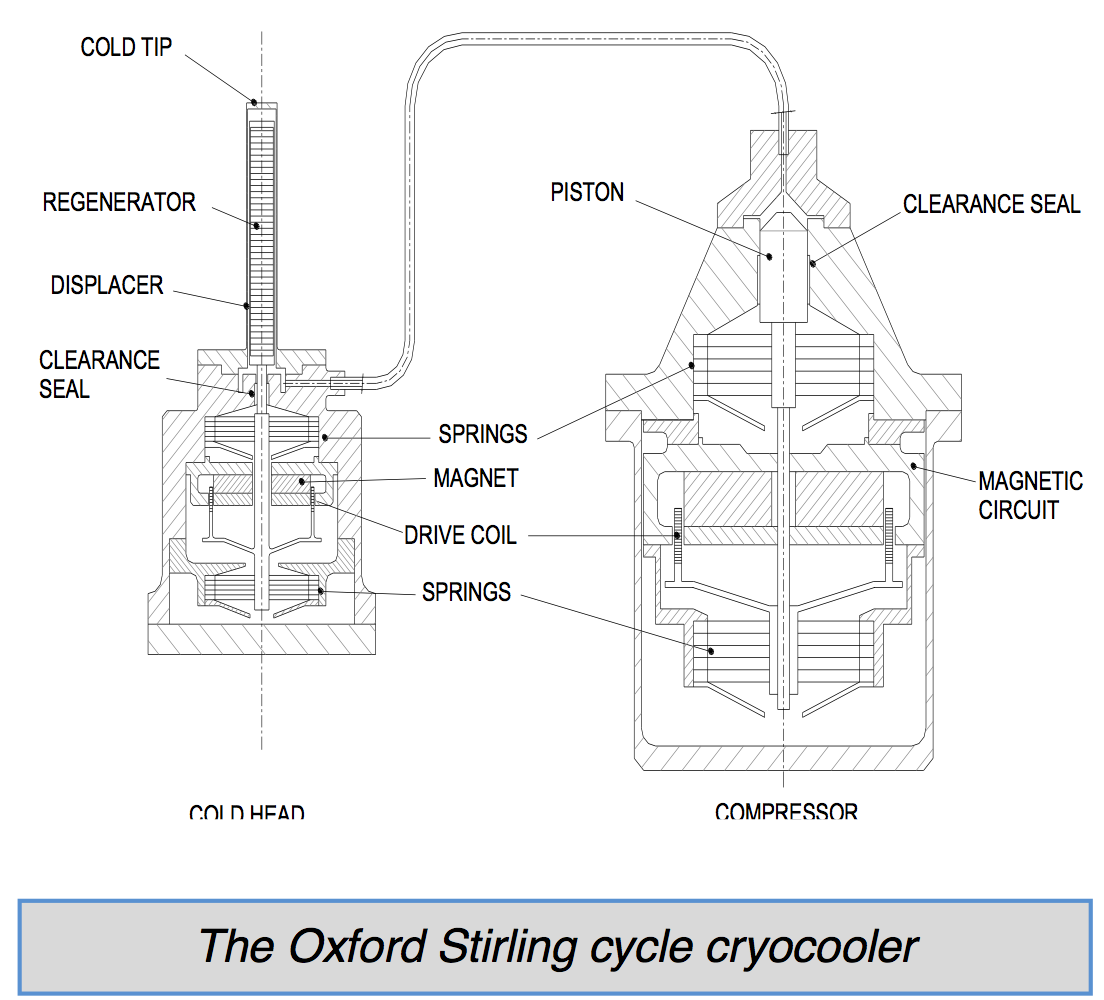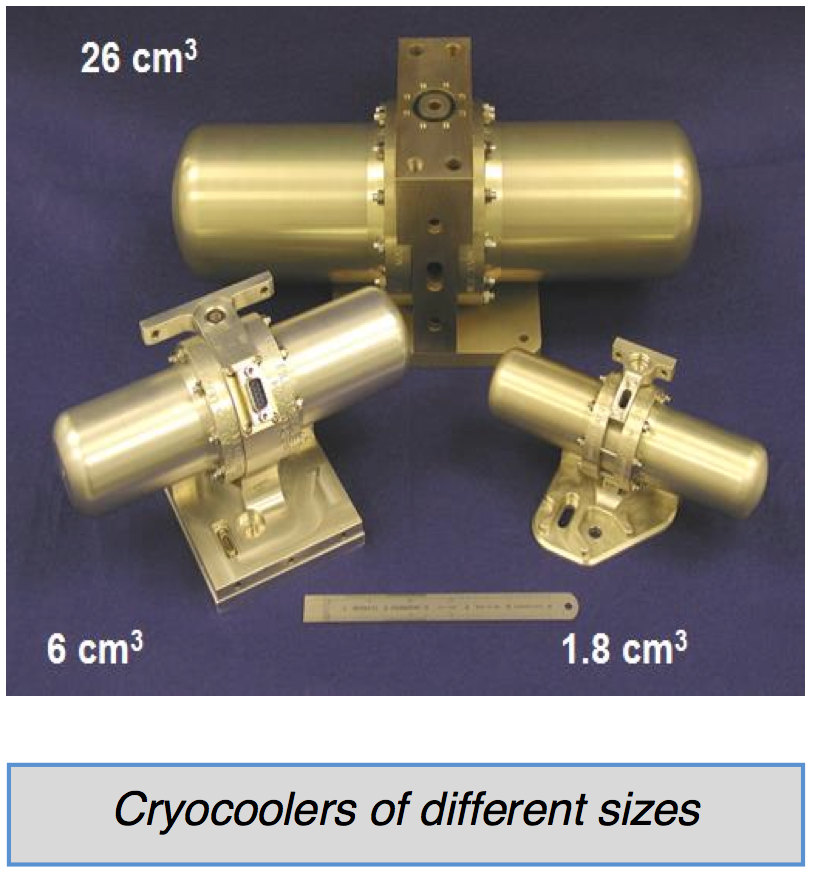UOA15-09: Compact, lightweight compressors for space applications
Submitting Institution
University of OxfordUnit of Assessment
General EngineeringSummary Impact Type
TechnologicalResearch Subject Area(s)
Physical Sciences: Other Physical Sciences
Information and Computing Sciences: Artificial Intelligence and Image Processing
Engineering: Interdisciplinary Engineering
Summary of the impact
Compressors developed at the Department of Engineering Science have
formed a key component of the cryocoolers used to cool the infra-red
sensors on satellites. Their low mass has trimmed almost $250k from the
cost of individual satellite missions. Sixty seven have been sold to date,
with sales totalling £2.8M between January 2008 and July 2013; three units
are currently in Earth orbit with another nine planned to follow in 2014.
A specialised version has been developed to achieve extremely low
temperatures, with prototypes already built for the Mid Infra-Red
Instrument (MIRI) that will form part of the James Webb Space Telescope.
Underpinning research
The development of Oxford compressors has been on-going for many years,
with its design being continuously re-evaluated, improved and refined.
This study relates to the impact of the current, third-generation device,
developed since 1995.

- The development of this technology began in 1978, when research was
initiated on the original `Oxford-style' compressor for use in long-life
Stirling cycle cryocoolers designed for orbiting satellites. Later, a
second-generation `integral cooler' was developed for lower-cost
Earth-based applications.
- Work on the third-generation compressor was triggered in 1995 by a
requirement from US-based firm TRW — now part of Northrop Grumman
Corporation (NGC) — for a small, high power density compressor
compatible with the envelope of an existing short-life cooler. The work
was led by Dr Mike Dadd, responsible mainly for scientific design, and
Paul Bailey, responsible mainly for engineering design (both joined the
Department in 1985 and are still in post). In 2005, Professor Richard
Stone, who joined the Department in 1993 as a University Lecturer and is
also still in post, took over from Dr Gordon Davey as academic lead on
the research.
- The resulting design, licensed to TRW in 1997, offered a higher power
density and thus a higher efficiency than existing devices [1]; and was
also easier to manufacture. The technology is partly protected by a US
Patent [2], with many other details proprietary.
- Key features of these third-generation compressors include: a small
clearance (10-1603bcm radially) between the piston and cylinder,
ensuring that gas leakage is negligible; diaphragm springs that allow
axial, but not radial, piston movement; and a linear electromagnetic
drive with a moving coil (similar to a loudspeaker).
- The specific improvements that this design delivered were increased
magnetic flux density in the air gap, reduced overall motor size and a
reduction in the stray magnetic field around the compressor [3].
Electromagnetic, thermal, stress and thermodynamic modelling carried out
by Dadd and Bailey led to the manufacture of single compressors each
with a separate momentum balancer incorporated into the pressure vessel.
- TRW further requested the design and manufacture of `balanced pair'
compressors (see photo), building on the previous design [4] as part of
this development process. When combined with TRW pulse-tube cold heads,
the complete cryocooler was smaller and at least 16% more efficient than
anything else available.

Due to commercial sensitivity, many technical details about the
third-generation design remain unpublished; published papers are typically
limited to details of system performance. However, projects funded by the
US Air Force (USAF) and by TRW involved detailed investigation of:
- The reduction of vibration from the compressors as a result of
improved balancing. This is crucial in satellite applications, where
excessive vibration can harm optical measurements.
- The effect of geometrical factors on the linearity of piston motion in
the compressors [5].
In 2005, a paper summarising USAF-funded research conducted by the
research team, focusing on motor and thermodynamic losses, secured the
Russell B Scott Memorial Award for Best Paper at the Cryogenic Engineering
Conference in Keystone, Colorado [6].
References to the research
(best indicators of research quality are marked `Q')
1. Curran, D.G. et al. `Space Cryocooler Vendor Survey Update:
2007' (2008). Aerospace Report No. TOR-2008 (1033)-7691, Aerospace
Corporation, El Segundo, California.
(Confidential document held on file and available on request)
Survey of space cryocoolers, including data on mass per unit of
cooling power.
2. Dadd, M.W. Linear Compressor Motor. US Patent 6127750 (3/10/2000).
http://www.google.co.uk/patents/US6127750
4. Bailey, P.B., Dadd, M.W., Hill, N., Cheuk, C.F., Raab, J. and Tward,
E. `High Performance Flight Cryocooler Compressor' (2001). Cryocoolers,
11, pp 169-174. Kluwer Academic/Plenum Press, New York. http://www.hymatic.co.uk/stirling.cryocooler.tp1.htm
`Q'
Paper describing the performance of a cryocooler incorporating the
third-generation compressor.
5. Dadd, M.W., Bailey, P. B. and Davey, G. `The Linearity of Clearance
Seal Suspension Systems' (2003). Cryocoolers, 12, pp 255-264.
Kluwer Academic/Plenum Press, New York.
http://dx.doi.org/10.1007/0-306-47919-2_35
`Q'
Paper on factors affecting linearity of motion of a piston mounted on
diaphragm springs.
6. Reed, J., Bailey, P. B., Dadd, M.W. and Davis, T. `Motor and
Thermodynamic Losses in Linear Cryocooler Compressors' (2006). Advances
in Cryogenic Engineering, 51a, pp 361-368. AIP, New York. http://dx.doi.org/10.1063/1.2202436
`Q'
Grants in support of this research:
• Northrop Grumman, contracts totalling £1.73m, 1995-2013
• USAF, contracts totalling £300k, 1998-2011
• EPSRC (EP/E036899/1), £246k, 2007-2010
Details of the impact
In the space sector, demand is growing for cost-effective solutions to
the challenge of cooling satellite sensors. Infra-red sensors, in
particular, are used in a wide range of satellite applications such as
deep space astronomy, missile detection and measurement of ocean and land
surface temperatures. The compressors' proven ability to meet this need is
reflected by their total sales of £5.7M [7], estimate £2.8M between
January 2008 and July 2013. Satellite systems where they are currently
deployed include:
- JAMI (Japanese Advanced Meteorological Imager), launched in 2005 and
scheduled to remain in orbit till 2015, see http://www.wmo-sat.info/oscar/instruments/view/236.
- GOSAT (Greenhouse Gases Observing Satellite), launched in 2009. Seven
compressors are also currently in production. Other key developments
have included:
- Addition of valves to transform the device from a `pressure wave
generator' into a `conventional' compressor. One such unit is to be used
to drive a Joule-Thomson cryocooler that will provide the James Webb
Space Telescope's MIRI instrument with cooling to 6 Kelvin [8]. Two
prototypes have been produced and manufacture of the flight units is now
under way.
- Modification of the technology to provide the basis for a small engine
capable of generating electrical power for deep space and planetary
missions. Working with TRW and NASA, the team modified a 6cm3
compressor by increasing the piston and cylinder size to give a swept
volume of 21cm3; this device was then used as an expander in
a thermo-acoustic Stirling heat engine [9]. An electrical power output
of 40W was achieved with a thermal efficiency of 18%.
The research underpinning the compressors has achieved three key impacts,
with the benefits felt by the space industry and beyond:
Economic Impact 1 — savings in satellite launch costs:
Third-generation `Oxford-style' compressors deliver substantial cost
savings for satellite missions when combined with pulse-tube cold heads
manufactured by NGC. This is because the compressors' smaller size,
compared to rival technologies, leads to reduced satellite weight and
therefore a cut in launch costs. With the cryocooler weighing about 12kg
less than alternatives [10] and satellite launches costing around
US$20,000 per kg [11], the result is a saving of US$240,000 per mission.
The Cryocooler Systems Manager at NGC has confirmed that "The high
reliability, small size, low mass and efficiency of the compressors
incorporated into a pulse tube cooler has been a significant advantage to
us, ..." [12]. Moreover, due to the higher efficiency of cryocoolers
incorporating the compressors, smaller solar arrays are needed to power
them; the radiator area for heat rejection can also be reduced — further
reducing the mission cost.
Economic Impact 2 — cost savings for satellite missions:
Previously all compressors were uniquely developed for each system, which
had to bear the costs of the device development and qualification testing
for space flight (typically $5-10M). Oxford's third generation devices are
now available as off-the-shelf products which are "flight qualified".
This was achieved through close collaboration between Oxford University,
TRW and Hymatic (now Honeywell Hymatic, Redditch, UK) which aimed to
further develop the compressor after the successful creation of prototype
units. Hymatic successfully manufactured a `productionised' version
featuring enhanced in-process testing to verify the process [13]. Hymatic
subsequently manufactured families of `balanced pair' compressors
developed at Oxford, (Section 2) with displacements of 1.8cm3
(1998), 26cm3 (1999) [14], and even as small as 0.6cm3
(2003) [15]. Ease of manufacturing the compressor has led to a significant
cut in the cost of in-space cooling.
Economic Impact 3 — wider economic benefits and wealth creation:
Honeywell Hymatic sales for this product, manufactured in the UK, have
totalled £5.7M, with £2.8M generated from January 2008 to July 2013. The
company's Engineering Manager confirms that "this product line is a
significant part of our business, and we anticipate that it, and future
related products, will continue to be an increasing part of our strategic
business model for years to come" [7].
Income to the University through a
licensing agreement with TRW amounted to £99,640 (gross) between 2008 and
the end of 2012 [16]. The cryocoolers' success has resulted in NGC
securing a significant share of the US market, with devices based on the
licensed technology sold to major US aerospace companies, resulting in 16
out of the 19 long-life coolers currently in orbit being based on Oxford
designs [12]. Although these cryocoolers have largely been sold to US
firms, a collaborative project involving NGC, Systems Engineering &
Assessment Ltd (based in Bristol), Honeywell Hymatic and the UK Science
and Technology Facilities Council is currently adapting the compressor for
use with a Stirling cold head in a cryocooler for the European Space
Agency.
Sources to corroborate the impact
- Letter from the Engineering Manager, Honeywell Hymatic. Corroborates
their sales and that the product is significant in Honeywell's business.
- Petach, M. et al.. `MIRI Cooler System Design Update' (2011). Cryocoolers,
16, pp 9-12. ICC Press, Boulder, Colorado. http://hdl.handle.net/1853/38740
Paper describing the cooling system for the MIRI instrument.
- Petach, M., Tward, E. and Backhaus, S. `Design of a High Efficiency
Power Source (HEPS) Based on Thermoacoustic Technology' (2004). Final
Report for NASA GRC Contract NAS3-01103. http://www.lanl.gov/projects/thermoacoustics/Pubs/HEPSFinalDraftU.pdf
- Pettyjohn, E. `Cryocoolers for Microsatellite Military Applications'
(2011). Cryocoolers, 16, pp 709-713. ICC Press, Boulder,
Colorado
https://smartech.gatech.edu/bitstream/handle/1853/39788/086.pdf?sequence=1
Paper stating that "space cryocoolers usually weigh 22-25kg"; cf.
the total mass of a cryocooler incorporating the Oxford-style
compressor, which is 7.4kg [1]. The estimate of reduced mass is
conservative.
- Futron Corporation. `Space Transportation Costs: Trends in Price Per
Pound to Orbit 1990-2000' (2002).
http://www.futron.com/upload/wysiwyg/Resources/Whitepapers/Space_Transportation_Costs_Trends_0902.pdf
Gives launch costs as US$17,032 or US$6,967 per pound mass,
depending on launch vehicle, for geosynchronous orbit, interpreted
conservatively at 2013 prices as US$20,000/kg.
- Letter from Cryocooler Systems Manager, NGC. Corroborates the
minimised size/weight.
- Cheuk, C.F., Hill, N.G., Strauch, R., Bailey, P.B. and Raab, J.
`Producibility of Cryocooler Compressors' (2003). Cryocoolers,
12, pp 275-281. Kluwer Academic/Plenum Press, New York.
http://www.eng.ox.ac.uk/cryogenics/publications/abstracts/stirling.cryocooler.tp2.pdf/view
Paper describing some of the in-process testing.
- Jaco, C., Nguyen, T., Colbert, C., Pietrzak, T., Chan, C.K. and Tward,
E. `High Capacity Staged Pulse Tube Cooler' (2004). Advances in
Cryogenic Engineering: Transactions of the Cryogenic Engineering
Conference — CEC AIP Conference Proceedings, 710, pp 1263-1268.
http://dx.doi.org/10.1063/1.1774813
Paper describing the largest in this family of compressors, mated to
a multi-stage cold head.
- Petach, M., Waterman, M.C., Tward, E. and Bailey, P.B. `Pulse Tube
Microcooler for Space Applications' (2007). Cryocoolers, 14, pp
89-93. ICC Press, Boulder, Colorado.
http://minds.wisconsin.edu/handle/1793/21708
Paper describing the smallest in the family of compressors.
- Senior Technology Transfer Manager, Isis Innovation. Corroborates
income to the University.